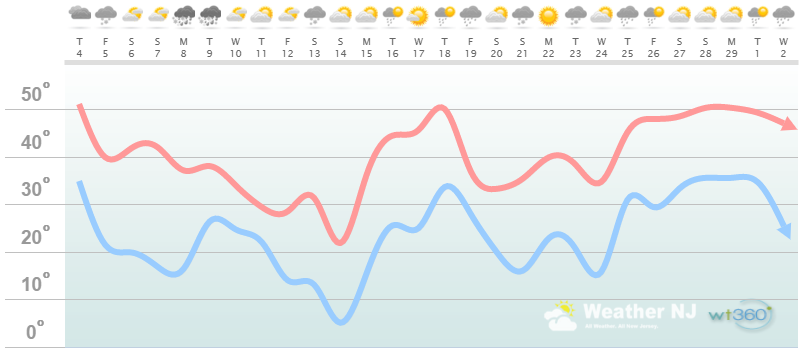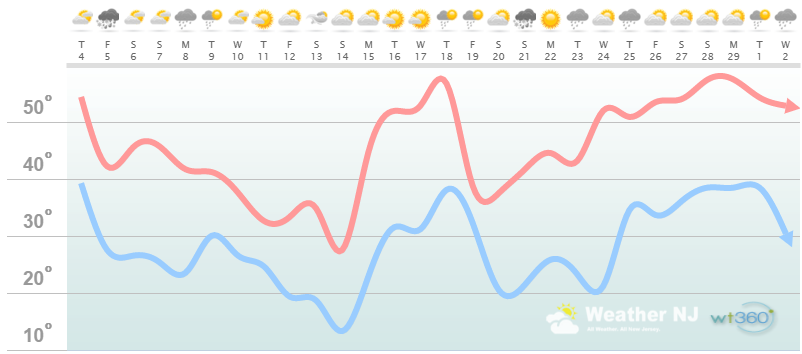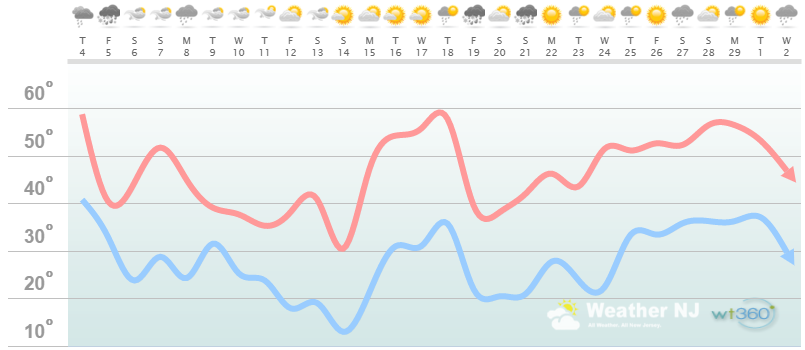Long Range Outlook through February 2016

It’s time to harness the WeatherTrends360 proprietary weather algorithms to see how the rest of February plays out. But first lets break New Jersey into proper climatological regions. We have the higher elevations of NNJ/NWNJ, the interior coastal plain (SWNJ through CNJ and into NENJ), and the coastal regions (most of SENJ). I’ll be representing each climatological region with a 28-day graph from weathertrends360 data followed by a brief discussion. Please keep in mind that these algorithms are documented with an 84% verification rate and are based on oceanic water cycles and time table series. Do not focus on specific detailed daily forecasts (sun vs clouds, etc). Focus on general trends (cool vs warm, rainy vs dry, etc). That’s what WeatherTrends360 does best.
Higher Elevations of NNJ/NWNJ
(Sussex, Warren, Hunterdon, Morris, N. Somerset, and N. Passaic) – Known for little to no Atlantic Ocean influence, colder-snowier winters, and drier conditions in general when compared to the coast. This region is known to get hot when high pressure sits overhead during the summer and bitterly cold during Arctic outbreaks in the winter.
Higher Elevation Discussion: The first half of February should feature declining temperatures until about the middle of the month. This is when the polar vortex will send a piece of its energy southward first into the central US which will then make its way into the E. US. The coldest part of the air mass appears rather transient (Feb 10th through 15th) as temperatures moderate from about the 15th through the 20th. One final cold shot (less intense than 10th through 15th) for the 20th through the 25th followed by more moderation through leap year. As far as precipitation goes, I see plenty of rainfall scattered with sunny days between. With that said, precipitation should be average to above-average through February with fluctuating transient periods of both cold and warmth. Plenty of snowfall opportunities left despite an overall mild winter.
Interior Coastal Plain from SWNJ-CNJ-NENJ
(Salem, Gloucester, Camden, W. Burlington, Mercer, W. Monmouth, Middlesex, S. Somerset, Union, Essex, Hudson, Bergen, and S. Passaic) – Known for naturally higher temperatures due to lower elevations away from the oceanic influence. This region is also known as “heat island” due to transportation (I-95 corridor), smog, abundant asphalt, concrete, and other man-made substances that naturally absorb and retain heat moreso than natural protected land.
Interior Coastal Plain Discussion: The first half of February should feature declining temperatures until about the middle of the month. This is when the polar vortex will send a piece of its energy southward first into the central US which will then make its way into the E. US. The coldest part of the air mass appears rather transient (Feb 10th through 15th) as temperatures moderate from about the 15th through the 20th. One final cold shot (less intense than 10th through 15th) for the 20th through the 25th (meh for snow) followed by more moderation through leap year. As far as precipitation goes, I see plenty of rainfall scattered with sunny days between. With that said, precipitation should be average through February with fluctuating transient periods of both cold and warmth. Plenty of snowfall opportunities left despite an overall mild winter.
Coastal Regions of SENJ
(Cumberland, Cape May, Atlantic, E. Burlington, Ocean, and E. Monmouth) – Known for tremendous influence from the Atlantic Ocean. Oceanic influence keeps this zone cooler in the summer and warmer in the winter than the interior coastal plain and especially the higher elevations of NWNJ. This forms a micro-climate that only local inhabitants and frequent visitors are familiar with.
Coastal Region Discussion: The first half of February should feature declining temperatures until about the middle of the month. This is when the polar vortex will send a piece of its energy southward first into the central US which will then make its way into the E. US. The coldest part of the air mass appears rather transient (Feb 10th through 15th) as temperatures moderate from about the 15th through the 20th. Then just a few colder days followed by more moderation through leap year. As far as precipitation goes, I see plenty of rainfall scattered with sunny days between. With that said, precipitation should be average through February with fluctuating transient periods of both cold and warmth. A few snowfall opportunities still exist despite an overall mild winter.
In English: Based on the data from Weathertrends 360 and the general pattern I see an overall mild month with a few transient cold shots capable of producing snowfall. NNJ looks a little rainier than SNJ (split at I-195) but overall, average to above-average precipitation is expected through the rest of February.
Weathertrends360 is a complete, global, web solution to help retailers and suppliers capitalize on the weather and its influence on sales and marketing plans up to a year ahead. Learn how to become PROACTIVE vs REACTIVE with the weather in every phase of your business – how much inventory to buy/produce, where to allocate more/less, when to run weather-optimized advertising/marketing campaigns – weathertrends360 can help you determine all of this in minutes! 84% independently audited accuracy for both short-term and year-ahead forecasts for temperature and precipitation.
A forecast Weather Trends issued one year ago is more accurate than every other weather company’s 5 to 14-day forecasts. The University of Miami and West Point PhD Climatologist’s prove WTI’s year-ahead forecasts are several times more accurate than NOAA – Click to Download Report. Also check out their free txt and email alerts!
Jonathan Carr (JC) is the founder and sole operator of Weather NJ, New Jersey’s largest independent weather reporting agency. Since 2010, Jonathan has provided weather safety discussion and forecasting services for New Jersey and surrounding areas through the web and social media. Originally branded as Severe NJ Weather (before 2014), Weather NJ is proud to bring you accurate and responsible forecast discussion ahead of high-stakes weather scenarios that impact this great garden state of ours. All Weather. All New Jersey.™ Be safe! JC











